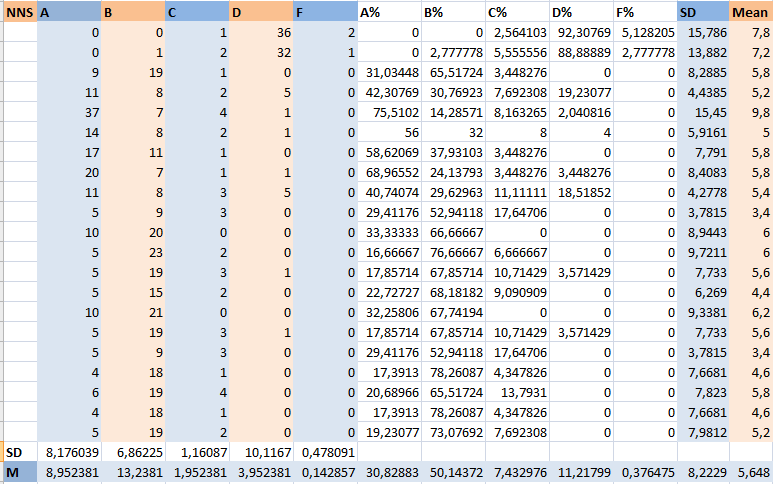Abstract
Promoting active information acquisition among students is a challenging task for any teacher. However, it becomes even more complicated to empower learners to attain success when having a poor understanding of their culture or language. Although non-native speakers (NNS) of English can deliver rather efficient results as teachers, the challenges, which they have to overcome, are much more numerous; therefore, the performance rates of the students, who are taught by NNS teachers, is likely to be considerably lower than those of the learners taught by NS instructors.
The reasons for the specified assumptions concern not the level of subject mastery displayed by the NS and NNS teachers, but the performance rates displayed by their students. A study involving a qualitative analysis of the performance tendencies among the students of NS and NNS teachers displays that the latter are more prone to the problems concerning misunderstanding or misinterpreting specific concepts regarding the subject than those having NS teachers as instructors.
The study also shows that the specified tendencies can be addressed, and the performance of students can be instructed by NNS teachers can be improved significantly once adequate strategies concerning the use of proper teaching tools are incorporated into the lesson design. Particularly, the use of visual aids, as well as other means of getting the message across in a manner as clear and efficient as possible, needs to be considered.
Introduction: Addressing the Core Problem
Facilitating high-quality education in an environment shaped by globalization is a tricky task. The quality of the staff’s performance defines the success of learners to a considerable degree; therefore, with the development of a multicultural environment, in which non-native speaking teachers could instruct students and provide them with the necessary information, questions regarding the possibility for students to understand the source material have been raised (Wong & Barrea-Marlys, 2012). Particularly, it is doubted that non-native speakers (NNS) can attain the voice of the classroom (VoC) in the course of the teaching process. Although NNS may deliver less impressive results than NS as far as the achievement of proper VoC rates is concerned, the incorporation of the teaching approaches focused on the development of independence and self-directed learning among students will help NNS create the environment, in which the students will be able to evolve and become independent learners.
In the course of the study, forty environments have been identified and studied; nineteen of them were created by native-speaking teachers, whereas the rest were designed by non-native speakers. The statistical data regarding the students’ performance was gathered; particularly, the number of learners achieving the scores of “A,” “B,” “C,” “D,” and “F” was estimated. Afterward, a statistical analysis based on the calculation of the elements such as the mean and the standard deviation of the students’ performance, as well as the regression analysis, has been conducted. The information retrieved in the course of the research serves as not only the proof of the increased efficacy of NS compared to NNS in the school setting but also informs the teachers on the further avenues to be taken as far as the teaching of the Arabian language is concerned. Specifically, the use of the opportunities for self-directed learning (Colin & Hammond, 2013) and metacognition (Vandergrift & Goh, 2012), which the learning environment created by NNS provides, deserves to be mentioned as a crucial outcome of the study.
Background: NNS Teachers and NS Teachers
The process of teaching has become more complex in the environment of global education. Particularly, the significance of meeting the needs of students as individuals and adapting towards their learning styles, thus, improving the quality of education significantly, can be viewed as one of the key changes in the designated area.
However, apart from the above-mentioned alterations, significant changes seem to have occurred to educators and the very theory of teaching; particularly, the introduction of non-native speaking teachers (NNS) into the target background can be interpreted as one of the essential modifications of the learning environment. The specified change was inhibited partially by the changes in the demographics, or, to be more exact, by the drastic increase in the number of learners (Klemencic & Fried, 2012).
Therefore, the existence of NNS in the educational background is a part and parcel of modern reality. However, due to the language issues that may emerge in the course of the learning process, the efficacy of NNS can be questioned. Moreover, because of the obvious need to introduce an increasingly large amount of NNS into the designated environment, the design of an approach that will help improve the overall quality of their teaching strategies will be required.
Problem: Native Speakers, NNS Teachers, and Student’s Performance
As it has been stressed above, the efficacy of NNS as educators can be questioned because of the obvious concerns regarding the communication process. Indeed, a closer look at the specifics of information transfer from an NNS to NS will reveal that the pieces of data transmitted in the process may undergo significant changes when passed from an NNS teacher to an NS learner; as a result, the latter’s concept of the subject matter may not coincide with the desirable one.
As a result, the students’ performance may drop due to the poor quality of the communication process between the teacher and the learners. More importantly, the issues that the students may experience when communicating with an NNS teacher may snowball to the point where the former may lose an opportunity to become proficient in the subject in question. Recent studies (Braine, 2010; Mahboob, 2010) say that the aforementioned concerns are not far-fetched at all. As a 2012 research study explains, the NNS teachers are very likely to face the issues related to language and understanding regularly in the target environment without proper skills:
If teacher candidates are asked to think about methodology and their L2 acquisition, one can conclude from the findings in this study that their assumptions about what is effective teaching will be based on prior experience. Once teacher candidates reflect on CLT versus more traditional methodologies with which they are familiar, a positive or negative conclusion toward CLT is established. (Wong & Barrea-Marlys, 2012, p. 71)
Therefore, the problem exists and needs to be addressed. More to the point, the issue in question may be viewed from a different angle. Because of the concerns about the progress of students, people tend to overlook NNS as a valuable resource (Kumaravadivelu, 2013). Therefore, a negative paradigm leading to the evolution and further blossoming of prejudice in the educational setting is created. Unfortunately, the specified instances are not quite rare among students and instructors alike (Jang, 2015); therefore, detailed tests will have to be carried out to prove that the efficacy of NNS teachers depends on a variety of factors and, more to the point, can and will be improved once the corresponding strategies are implemented. The study, thus, aims at proving that the aforementioned VoC can be achieved in both the learning environment created by an NS and the one created by an NNS, as well as the fact that the process of VoC achievement can be enhanced with the help of strategies aimed at improving the efficacy of communication in the setting, where NNS instruct learners.
Research Description
Goals: Voice of Classroom
Defining the key goals of the study, one must mention that the research focuses on the analysis of the differences in the performance of the students, who were taught by NS, and those, who were instructed by NNS teachers. Particularly, the research addresses the achievement of the voice of the classroom (VoC) in the designated settings and the comparison of the rates thereof among the NS and NNS correspondingly.
An analysis of the VoC rates in the settings headed by NS and NNS is the key objective of the research. To identify the problems, which both NS and NNS face in the specified environment, one will have to consider the fact that NNS teachers have the largest percentage of B- and, unfortunately, D- and F-students, whereas the NS instructors seem to have very high rates of A- and B-students. The latter type of teacher, in fact, has the smallest number of D- and F-students. The identification of the issues that inhibit the development of VoC in the NS and NNS setting can be viewed as another strategy of the study. The development of the strategies that will help NS and especially NNS achieve a significant increase in the VoC rates is the final objective of the research. Particularly, the approaches aimed at enhancing the efficacy of communication among the students and the teacher will be considered.
Significance: When Every Discovery Counts
The significance of the study can be deemed as rather high since it addresses one of the basic problems, which teachers and students alike have to face in the environment of global education, as well as outlines the possible solutions for it. Although claiming that the study in question will have a groundbreaking effect on the theory of teaching would be wrong, the research still provides rather deep insight on the performance of NS and NNS teachers, therefore, building the foundation for making further assumptions regarding the strategies that NS and NNS teachers need to adopt to achieve higher VoC rates in the learning environment.
Theoretical Background: Where the Control Theory Meets Constructivism
To address the issues raised in the research, one will have to consider the changes in the students’ performance from two key perspectives, i.e., the Control Theory, which creates premises for understanding how the process of information transfer may occur between the students and the NNS teacher, and the Constructivist approach, which focuses on the process of knowledge building. The adoption of two separate theories as the tools for addressing the situation under analysis can be justified by the fact that the variables in question, i.e., the VoC, which is measured by evaluating the students’ performance rates (Stairs, Donnell, & Dunn, 2011), are placed in two different environments, i.e., the ones, in which an NS and an NNS perform the roles of teachers. In other words, two different experimental settings are created, which calls for the adoption of two appropriate theories.
Control Theory as the Means to Assess the Impact of NNS Teachers
First and most obvious, the above-mentioned issue regarding the communication process between NNS teachers and their students needs to be addressed as the most ambiguous one. The given issue can be approached from the tenets of the Control theory, as it states clearly that the process of knowledge acquisition can be managed by learners along with the teacher. Indeed, seeing that there is an obvious language issue in the scenario in question, one may assume that the learners have just as much, if not more, control throughout the lesson and, therefore, the transfer of information. According to a recent study, the control theory can be defined as the “theory of motivation that ties learning to what a person wants most at the given time” (Papa, 2011, p. 96); therefore, the specified approach allows the teacher to focus on the individual needs of each student and, thus, provide them with the information that they need.
According to the existing definition, the control theory suggests that the process of learning is enhanced not by the external stimuli but by the current needs and requirements of the student (Schwarzer, 2014). In other words, the control theory suggests that learners should be just as active in the process of defining the course of the lesson and the information that they will need later on to evolve in the designated area as their instructors should (Carey, 2012).
Constructivism as the tool for Approaching the NS Teachers’ Success
The Constructivism theory, in its turn, can be used as the means of evaluating the efficacy of the results delivered by the NS teachers (Fostnot, 2013). The assessment of the teachers’ efficacy in getting the key messages to the students across and helping them acquire the necessary knowledge will be assessed based on the students’ ability to understand the messages in question and construct the corresponding knowledge on their own, therefore, building awareness regarding their learning process (Akyol, 2012).
The Constructivism approach, being the strategy that helps “using our words to further our understandings as well as those of others” (Bentley, 2013, p. 44), allows enhancing the process of acquiring the necessary information and understanding it so that the learners could solve complex tasks based on the theory in question.
A combination of the two theories described above will allow for a deeper insight into the changes, which the NS and NNS teachers have contributed to in the designated setting. Both theories will shed some light on the importance of the clarity of the message conveyed by the instructor (Benton, 2014), as well as the necessity for the teacher to provide the visualization of the required concepts. In other words, the theories listed above will help state whether the learners are capable of constructing the necessary image and, therefore, a concept based on their ability to navigate and even guide the process of knowledge acquisition (Wang, 2011).
Discussion of Findings: Learning Teaching
NNS Teachers and Their Students’ Progress
According to the results of the analysis, there is a significant lack of VoC in the learning environment, where NNS teachers are present. Although the performance of the students, which are instructed by the teachers in question, cannot be deemed as entirely negative, the correlation between the VoC rates among the students instructed by NNS and NS points to the need to adopt the tools that will allow raising the VoC rates in question by improving the performance of learners and enhancing the efficacy of communication between them and their instructors. Particularly, the fact that most learners retrieved D and C marks during lessons deserves to be brought up. A closer look at the analysis results will reveal that the rates of C-, D- and F-students are much higher among the NNS teachers than the NS ones.
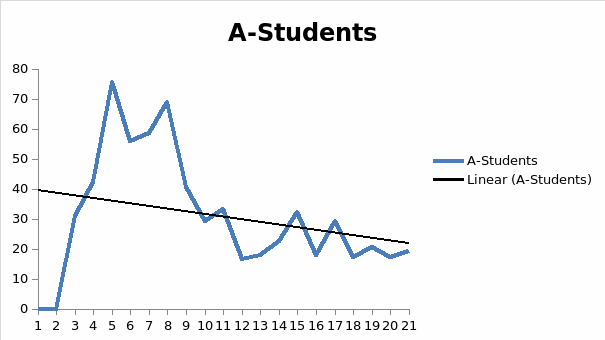
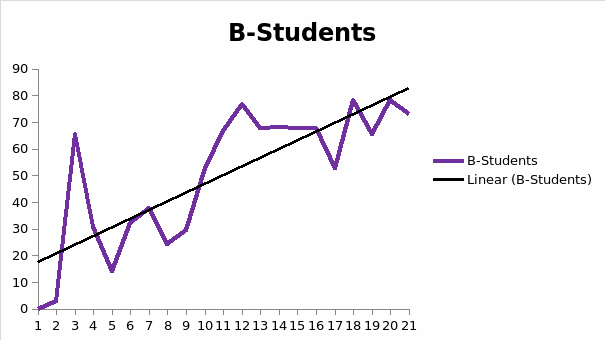
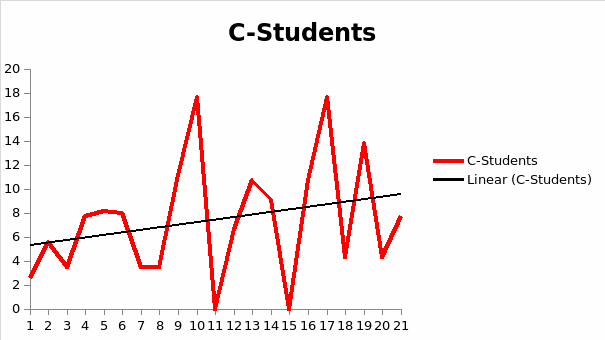
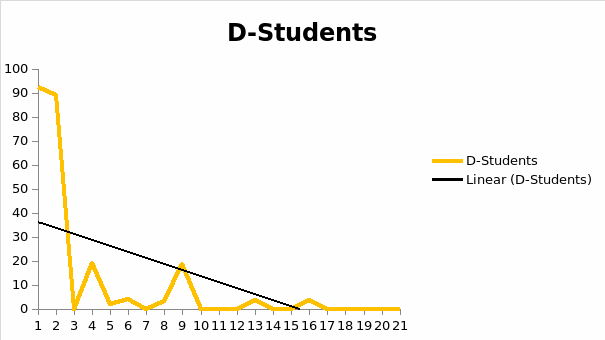
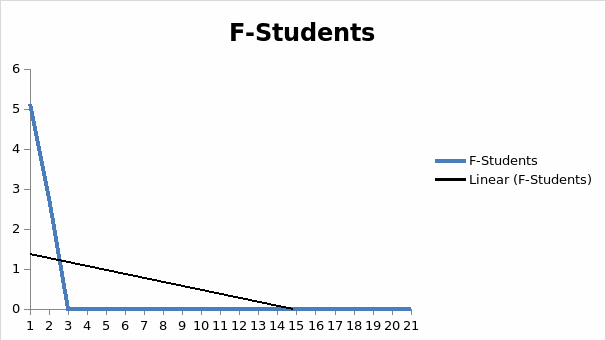
It is quite remarkable that the standard deviation rates of VoC in each group vary to a considerable extent; at some point, the SD reaches 15.7, which can be considered a rather high difference rate given the fact that the groups, in which the assessment took place, are rather small. According to the analysis carried out, there are obvious tendencies for an increase in the number of students performing positively; particularly, the average number of B- and C-students seems to be increasing gradually, as the trend lines in the corresponding graphs display. The number of A-students, however, is declining, which means that NNS teachers should consider the communication tools that will increase the rates of VoC in the target environment. The research has also shown that the NNS teachers deliver less satisfying results than the NS ones; particularly, the number of D-students peaks in the specified environment, which means that significant changes have to be introduced into the designated
It should be noted, though, that some of the data retrieved in the course of the analysis point to the fact that the NNS teachers may succeed at some aspects of teaching to a greater degree than the NS instructors do. Particularly, NNS teachers tend to promote independence among learners, thus, creating the environment, in which the students are welcome to digest the information provided to them in the course of the lesson in the way that they are the most comfortable with. In other words, NNS teachers do not foist a specific mode of thinking onto the students; instead, they leave the lecture material free for interpretation, therefore, triggering an increase in creative thinking among learners. It should be noted, though, that the specified phenomenon typically occurs among the students that already have a substantive background regarding the subject matter and, therefore, are capable of forming an opinion on their own.
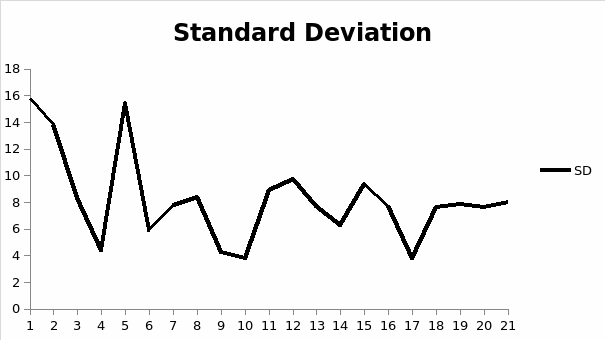
The chart provided above indicates clearly that there are significant differences in the VoC rates among the students belonging to a single group. While one group may have a rather large number of learners with high-performance rates, another group may display the students’ inability to grasp the problem suggested by the teacher by adopting the theory that was learned before completing the assignment. NNS teachers, therefore, may also achieve VoC in the environment of the classroom despite the language issues that they are most likely to have in the setting of a Saudi school.
The study has also shown in a rather evident manner that proficiency in the Arabic language, though being admittedly important for an Arabic language instructor, does not define the success of conveying the material to the students entirely. As the research has shown, several NNS teachers have reached the required VoC rates despite the language issues, which they must have been having with the students in the process.
NS teachers and Their Impact on Learners
The outcomes of the study show clearly that the rates of VoC are much higher in the groups led by NS. The specified results can be explained by the fact that NS teachers are most likely to find ways to express themselves with the help of both verbal and nonverbal elements of communication in the manner that the students are most likely to understand. The above-mentioned phenomenon aligns with the principles of the Constructivism theory. Seeing that the latter presupposes that the learners should be provided with an opportunity to build their understanding of the subject matter on the basis provided by the instructor and, therefore, be led by the latter so that they could expand their knowledge base, it will be reasonable to assume that the learners have much more chances for receiving decent scaffolding instructions and assistance from the teacher, who can convey the message on a variety of levels incorporating not only the words but also the options and concepts that are intrinsically characteristic of the culture of the students, the Arabic one being the case in point.
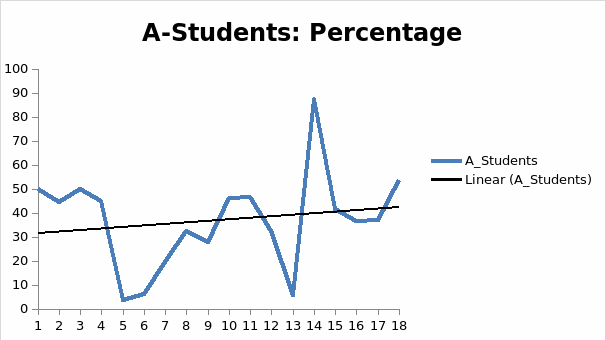
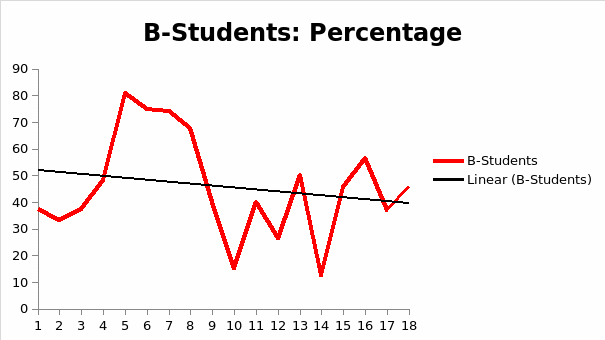
It is quite remarkable that the number of B-students among NS teachers is slowly declining. Therefore, it can be assumed that the VoC rates are growing in the specified environment. Much like the previous result, it can be explained by the fact that the Constructivism-related processes, which promote creative and logical thinking among learners, allows them to process the information provided by the teacher in the manner that links their background knowledge and vision of the world to the data offered by the instructor:
The constructivist theory of learning holds that people learn by constructing their understanding and knowledge of the world through experience and reflecting upon that experience. We are active creators of our knowledge, reconciling our previous ideas as we encounter new experiences and information. (Harasim, 2012, p. 47)
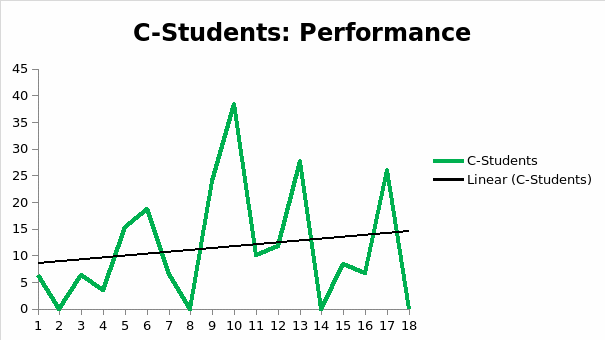
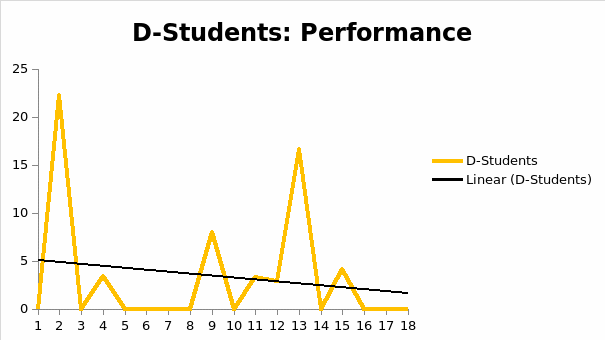
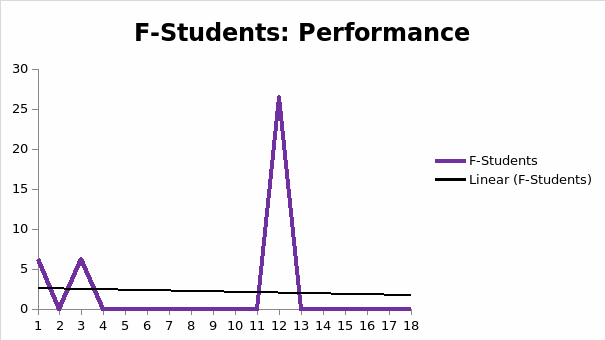
The latter two charts make it quite clear that the number of D- and F-students is slowly declining. Thus, as the chart provided above shows, the VoC rates among the students that were instructed by NS teachers can be deemed as rather high due to increasingly high-performance rates among the learners in question. According to the information retrieved in the course of the analysis, 37% of the students receive “A” marks on average. The same can be said about B-students; as the research results display in a rather graphic manner, at least 45.8% of learners achieve the specified mark. The number of C-, D- and F-students, on the contrary, is very low, the means being 11.6%, 3.4%, and 22% correspondingly. Moreover, the study has revealed that the standard deviation rates among the A-students in the designated groups are comparatively low (4.1), which means that the number of the students, who perform well, is similar in all eighteen groups supervised.
Unfortunately, the standard deviation rates among the learners of different performance rates in the target groups are also rather low, as the chart below shows. The specified characteristics of the experimental groups, however, can be attributed to the fact that the number of students in each of them is comparatively low (Rasinger, 2013); therefore, the slightest changes register as very high in the given setting.
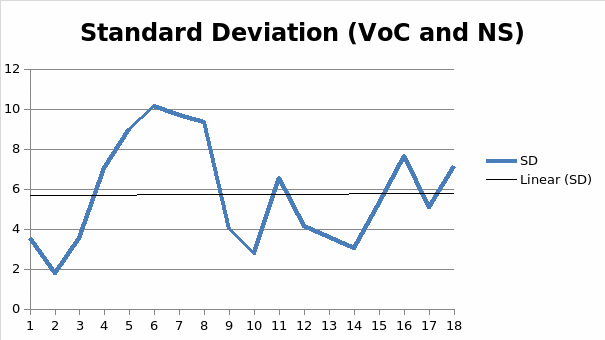
Hence, it can be assumed that VoC is achieved by NS teachers in most cases in the above-mentioned setting. Although the VoC rates achieved by NS may be viewed as questionable when considering the issues that some of the students might have due to the low-performance rates as displayed in the graphs above, the amount of A- and B-students is still far higher in the groups headed by NS than in those that are instructed by NNS. Indeed, according to Fig. 12, the differences in the VoC rates are considering lowering the groups led by NS. More importantly, the general tendency, which can be traced in the above-mentioned charts, can be defined as quite stable. Although the lack of growth as displayed by the trend line in Fig. 12 may be considered somewhat discouraging the absence of negative tendencies in the designated area should be interpreted as the perfect grounds for the promotion of new learning tools among the students and the process of testing new teaching approaches.
Suggestions
It can be suggested, therefore, that the NNS teachers should focus on the development of stronger ties with students by engaging in communication processes during lessons. Additionally, the fact that the students of NNS teachers are exposed to the environment, in which they are also capable of controlling the process of information transfer, makes it necessary to make sure that the target audience should be able to navigate the learning environment along with teachers, therefore, contributing to the development of lessons and steering the latter the direction that they feel necessary to digest specific bits of information.
As far as the improvement of the score delivered by the NS teachers is concerned, it is advised that the instructors should consider the tools that will help learners enhance their metacognition skills; particularly, the students will need to understand how exactly they acquire communication skills and adopt the identified approaches to their Arabic language practice. Seeing that communication is not an issue in the teaching process facilitated by NS, it is essential to identify the obstacles that block learners’ way to gaining the required knowledge and skills by improving the process of communication between the teachers and the learners. Once the latter is capable of identifying and naming the problems that they have in the course of learning, instructors will be capable of identifying the patterns that will help the students learn the necessary information in a manner as efficient and expeditious as possible (Hartman, 2013).
Conclusion
Summary: Surprising Discoveries and New Opportunities
According to the research outcomes, there is a direct correlation between the teacher’s native language and the students’ success rate; in other words, the connection between the VoC rates and the educator’s ability to use the concepts and notions that the students understand exists. Moreover, it defines the strategies that NS and NNS need to adopt to approach the learners efficiently and make sure that they can apply the information learned to solve a practical task. The research has also shown that
Recommendations: Improving the Overall Quality of Teaching
As the research has shown, the relationship between the native language of the teachers and the success of their students is quite obvious. Although the endeavors of NNS teachers are worth appreciating, the number of students, who seem to have problems with understanding the subject and developing the skills required to solve the related problems are worth appreciating, there is no need to stress that the number of A-students is much higher in the groups led by the NS teachers.
Herein the need to reconsider the teaching strategies used by NS instructors to achieve VoC lies. Increasing the rates of VoC among the Saudi teachers is essential to the improvement of students’ performance rates; as the analysis carried out above has shown, the students’ ability to interpret the information that is given to them depends largely on the instructor’s ability to deliver the key facts and assumptions in the manner that learners will find accessible.
Reference List
Akyol, Z. (2012). Educational communities of inquiry: Theoretical framework, research and practice. Washington, DC: IGI Global.
Bentley, D. F. (2013). Everyday artists: Inquiry and creativity in the early childhood classroom. New York City, New York: Teachers College Press.
Benton, C. (2014). Thinking about thinking: Metacognition for music learning. New York City, New York: R&L Education.
Braine, G. (2010). Nonnative speaker English teachers: Research, pedagogy, and professional growth. New York City, New York: Routledge.
Carey, T. A. (2012). Control in the classroom; an adventure in learning and achievement. Buffalo, New York: Living Control Systems Publishing.
Colin, M., & Hammond, R. (2013). Self-directed learning: Critical practice. New York City, New York: Routledge.
Fostnot, C.T. (2013). Constructivism: Theory, perspectives, and practice (2nd ed.). New York City, New York: Teachers College Press.
Harasim, L. (2012). Learning theory and online technologies. New York City, New York: Routledge.
Hartman, H. J. (2013). Metacognition in learning and instruction: Theory, research and practice. Berlin: Springer Science & Business Media.
Jang, L. J. (2015). Identity matters: An ethnography of two nonnative English-Speaking teachers (NNESTS) struggling for legitimate professional participation. In Advances and current trends in language teacher identity research (pp. 116–131). New York City, New York: Routledge.
Klemencic, M., & Fried, J. (2012). Demographic challenges and the future of the higher education. International Higher Education, 1(1), 12–14.
Kumaravadivelu, B. (2013). Rethinking global perspectives and local initiatives in language teaching. In S. B. Said & L. J. Zhang (Eds.), Language teachers and teaching: Global perspectives and local initiatives (pp. 317–323). New York City, New York: Routledge.
Mahboob, A. (2010). The NNEST lens: Non native English speakers in TESOL. Cambridge: Cambridge Scholars Publishing.
Papa, R. (2011). Technology leadership for school improvement. Thousand Oaks, California: SAGE.
Rasinger, S. M. (2013). Quantitative research in linguistics: An introduction (2nd ed.). A&C Black.
Schwarzer, R. (2014). Self-efficacy: Thought control of action. New York City, New York: Taylor & Francis.
Stairs, A. J., Donnell, K. A., & Dunn, A. H. (2011). Urban teaching in America: Theory, research, and practice in K-12 Classrooms. Thousand Oaks, California: SAGE Publications,.
Vandergrift, L., & Goh, C. C. M. (2012). Teaching and learning second language listening: Metacognition in action. New York City, New York: Routledge.
Wang, Y. (2011). Education and educational technology. Berlin: Springer Science & Business Media.
Wong, C. C. Y., & Barrea-Marlys, M. (2012). The role of grammar in communicative language teaching: an exploration of second language teachers’ perceptions and classroom practices. Electronic Journal of Foreign Language Teaching, 9(1), 61–75.
Appendix A: NS Teachers: VoC Rates
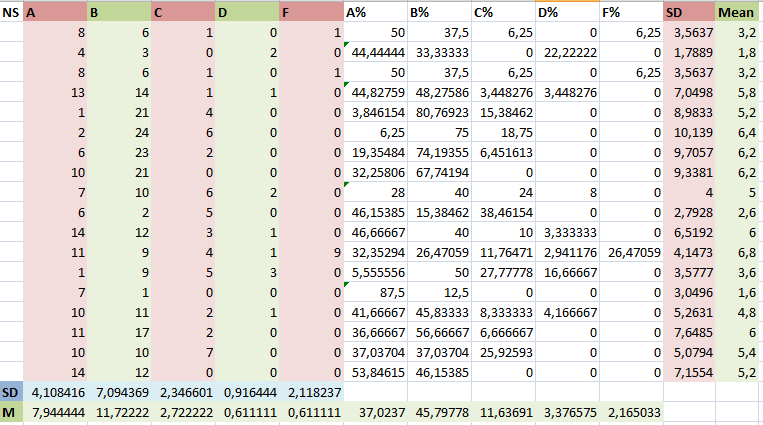
Appendix B: NNS Teachers: VoC Rates
